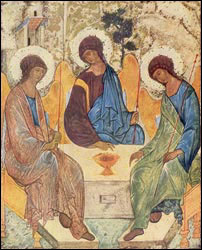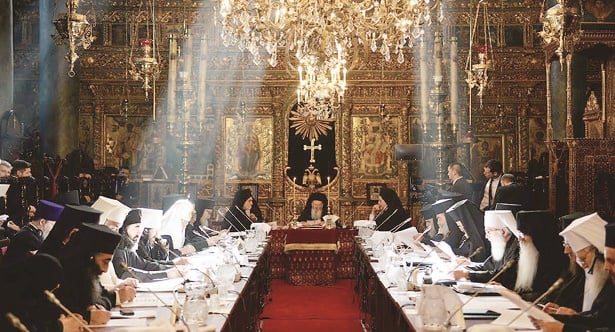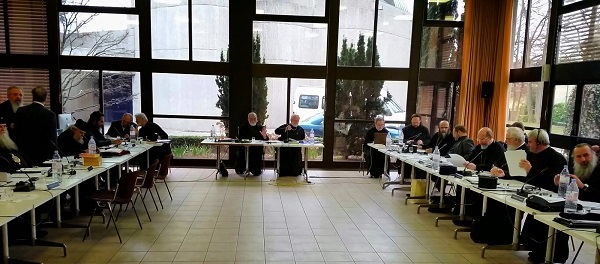The Orthodox Church and the Ecumenical Movement
An ecclesiological approach on the road to the Holy and great Synod
‘The Ecumenical Movement… is the greatest and most valuable ecclesiastical acquisition of the last century; maintaining, deepening enriching and stabilising it is the main obligation of Christians, primarily their leaders and shepherds, as well as of institutions and theological schools of all kinds during the current 21st century’. These words, from a person well-respected for his long and active involvement in the ecumenical dialogue, express precisely the task facing the Holy and Great Synod of the Orthodox Church, as regards its ecumenical duty.
After a long period of institutionalized isolation, of harsh prejudices over centuries, and very bitter confessional competition, a new page opened at the start of the 20th century, a new era in ecclesiastical history dawned, one characterized by a genuine and practical desire on the part of Christians to find opportunities for rapprochement, mutual acquaintance, cooperation and theological dialogue. In the midst of rapid social and political changes and crises, the Orthodox Churches, led by the Ecumenical Patriarchate, felt the need for the unity of the Churches and their common witness in a world seeking fresh orientation.
At the dawn of the 20th century, then, Orthodoxy entered onto the stage of the Ecumenical Movement with direct and significant actions: the Patriarchal Encyclicals of 1902 and 1904, and particularly that of 1920, referred with particular emphasis to the importance of strengthening the ties between the Orthodox Churches, as well as those with other Christian churches, in an ecumenical perspective. These letters are of very great importance. They were precursors of the main coordinates of the presence of the Orthodox Church in the broader Christian milieu and cleared the air for the start of the process of Synods in the Orthodox Church, which was promoted through the new institution of the Pan-Orthodox Conferences introduced by Ecumenical Patriarch Athenagoras.
The participation of the Orthodox Churches in the Ecumenical Movement facilitated and hastened this process. It is considered certain that the growth of the Ecumenical Movement inspired Patriarch Athenagoras to convene the 1st Pan-Orthodox Conference in Rhodes in 1961, as well as the others which followed in 1963 and 1964 in Rhodes and in Chambésy, Geneva in 1968.
The Pan-Orthodox Conferences and the progress of the synods towards the Holy and Great Synod of the Orthodox Church, a kind of ‘intra-Orthodox ecumenical movement’ one might say, were tools for expressing the unity and universality of the Orthodox Church and led the Orthodox to acquire a new ‘view’ of Orthodoxy and also equipped them for a consistent presence and commitment to the Ecumenical Movement.
In particular, the 1st Pan-Orthodox Conference in Rhodes in 1961 and the 4th in Chambésy in 1968 cleared the way for the Pan-Orthodox Pre-Synod consultations, confirmed the ‘presence and participation of the Orthodox Church in the Ecumenical Movement, in the spirit of the Patriarchal Encyclical of 1920’, tabled- for the first time on a Pan-Orthodox level- certain desiderata to the WCC, and, as Ioannis Karmiris has noted, through the Memoranda of the Conferences, the Orthodox Church appeared to the divided world ‘as a sign of unity’ as a ‘bridging Church’ and as an ‘evangelist of love’.
This was the perspective which motivated the 1st Pre-Synod Pan-Orthodox Meeting in Chambésy in 1976, which dealt, in particular, with the issue of the position of the Orthodox Church within the Ecumenical Movement and, in particular, the WCC. The Meeting made significant proposals concerning the ecclesiological conditions required for a well-conducted dialogue and for a substantial Orthodox contribution to the matter of ecumenical Christian unity.
Over the following years, as a consequence of the decisions of the Pan-Orthodox Conferences, the Orthodox participation in the Ecumenical Movement increased significantly and the contribution by the Orthodox Churches became more dynamic, worthwhile and creative.
This dynamic and creative participation was confirmed by the 3rd Pre-Synod, Pan-Orthodox Meeting in 1986 in Chambésy, as a stage of maturity and the culmination of a new era inaugurated by Ecumenical Patriarch Athenagoras with the Pan-Orthodox conferences. Twenty-five years after the adoption of the issue of the Ecumenical Movement into the agenda of the Holy and Great Synod, and after many significant stages, frank theological deliberations and intense discussions, the time is ripe for a formal, common stance on the part of the Orthodox Churches as regards the Ecumenical Movement. At the 3rd Pre-Synod Meeting, negotiations on the matters of ‘Relations between the Orthodox Church and the Rest of the Christ World’ and ‘The Orthodox Church and the Ecumenical Movement’ were concluded. The final texts, which were adopted unanimously, are the products of profound investigation, deliberation and also boldness. Although they dash any untimely hopes, they are imbued with a substantial affirmation of the ecumenical contacts and their direction, outlining their extent, their quality and their orientation.
In particular, the text on ‘The Orthodox Church and the Ecumenical Movement’, which is up-to-date in its references but timeless in its conclusions, was held to be most positive by the WCC and was considered an important contribution because, as was observed, very few member-churches of the Council have stated so clearly and in such detail the fundamental theological reasons for their participation in it. It is worth noting the following declarations by the 3rd Pre-Synod Meeting: ‘With its deep conviction and ecclesiastical consciousness that it is the bearer and witness to the faith and tradition of the One, Holy, Catholic and Apostolic Church, the Orthodox Church firmly believes that it occupies a central position in the matter of promoting the unity of Christians in the modern world… The Orthodox Church has always wanted to draw the various Christian Churches and Confessions into a common quest for the lost unity of Christians, with the aim that we should all agree on the unity of the faith.
The Orthodox Church prays constantly “for the union of all” and has participated in the Ecumenical Movement from the time of its first appearance, contributing to its expansion and further evolution. In any case, because of the Ecumenical spirit, which is a distinctive feature, it has, throughout history, always fought for the restoration of Christian unity. This is why the Orthodox participation in the Ecumenical Movement is not at all foreign to the nature and history of the Orthodox Church, but is a consistent expression of the Apostolic faith within new historical conditions and in order to meet new existential demands… The multi-dimensional ecumenical activity [of the Orthodox Church] arises from a sense of responsibility and from the conviction that coexistence, mutual understanding, cooperation and common efforts for Christian unity are essential so that “we should not place any obstacle in the way of the Gospel of Christ” (I Cor. 9, 12)’.
The positions of the 3rd Pre-Synod Meeting, which are exceptionally important and fruitful, as well as being of an enduring nature, naturally formed the core of the resolution of the 5th Pre-Synod Meeting of October 2015, with whole paragraphs being repeated word for word. The 5th Pre-Synod Meeting dealt with a revision and final ratification of, among other things, the texts of the 3rd Pre-Synod Meeting which had to do with the relations of Orthodoxy with the rest of the Christian world, as these were expressed in bi-lateral and multi-lateral talks.
The Conference naturally made some supplementary corrections and additions, but accepted the proposals of the Special Inter-Orthodox Commission on the preparation of the Holy and Great Synod (October 2014), which in contrast to the 1st and 3rd Pre-Synod Meeetings, unified items 8) Relations between the Orthodox Church and the rest of the Christian World and 9) The Orthodox Church and the Ecumenical Movement into one, entitled ‘Relations between the Orthodox Church and the rest of the Christian world’, thus avoiding the provocative reference to the ‘Ecumenical Movement’. This term is provocative for extreme circles and groups within Orthodoxy which are nourished by their segregation, and by the idée fixe of polemical conflict against any attempt on the part of the Church to embrace modern reality. It should be noted that at the session of the Special Inter-Orthodox Comission from 30 September to 3 October 2014, powerful voices were raised in favour of a firmer stand on the part of the Orthodox Churches towards the Ecumenical Movement and heterodox Christians. The ordination of women and the attitude of Protestant churches towards homosexuality were used, and continue to be used, by certain Orthodox circles as an alibi to halt, or at least restrict, ecumenical contacts
Of course, the text of the 5th Pre-Synod Meeting retained the core of the thinking of the 3rd, though did not proceed to any analytical critical evaluation of the progress and particular problems of all the bilateral discussions, as the 3rd Pan-Orthodox Conference had done. This point represents a deficiency, since thirty years of discussions had elapsed since the 3rd Pre-Synod and it would have been useful to take stock of the various components, achieved and pending, even if these are not referred to the Holy and Great Synod, because the talks are still under way. As regards this, in my opinion, neither dimension of the discussions, the multilateral or the bilateral, can be regarded as successful, because the methodology is different and because participation in multilateral talks and the institutional organs of the Ecumenical Movement involves cooperation on a practical level and the participation in multipartite activity in the fields of evangelizing, service, theological education, inter-religious dialogues, and the common Christian witness on justice, peace and the preservation of the environment: what was called in the Pan-Orthodox texts of the 60s and 70s the ‘horizontal line’.
Be that as it may, as has already been noted above it is positive that the fullest fruits and the framework of principles of the 3rd Pre-Synod Meeting have been retained, with certain supplements and addenda, which are a correct response to the most recent developments in the Ecumenical Movement and within Orthodoxy itself.
The most hopeful aspect is that the text submitted has given rise to opportunities for a deeper investigation of Orthodox ecclesiology, especially the study of the canonical criteria regarding the limits of the Orthodox tradition of the Church. This was already the desideratum as early as the 3rd Pre-Synod Meeting, because there was the conviction that it would allow a unified stance to be maintained by all the local Orthodox Churches during any discussion of ecclesiological texts. And something even more important. Since ecclesiology is the core of ecumenical deliberations and particular attention is paid to it in all discussions, an effort began to take shape from as early as the 70s, on a Pan-Orthodox level, to utilize the ecclesiological teaching of the Orthodox Church not only for a deeper understanding of its own consciousness, but also for a responsible evaluation of the form of ecclesiasticity of the Christian world which exists outside it, but which lives next to it and with it.
Irrespective of the final evaluation of the theological discussions, the Orthodox Church has managed not only to avoid categorizing Christendom into schismatic or heretical communities which are threatening it, but in the text ‘Relations between the |Orthodox Church and the rest of the Christian world’, from the 3rd Pre-Synod Meeting, it stated unanimously that: ‘The Orthodox Church, as the One, Holy Catholic and Apostolic Church, is fully aware of its responsibilities regarding the unity of the Christian world, recognizes the actual existence of all Christian churches and confessions, and also believes that relationships with them should be based, as far as possible, on the swiftest and most objective clarification of their teaching on the sacraments, grace, the priesthood, and the Apostolic succession’.
The above position, which is the most official attempt so far on a Pan-orthodox level to define the ecclesiological identity of the Orthodox Church with reference to the identity of the other Christian Churches and Confessions first took shape, in 1971, at the Inter-Orthodox Preparatory Commission for the Preparation of the Holy and Great Synod, in the extremely interesting text: ‘Dispensation in the Orthodox Church’.
In relation to this position, the then head of the Secretariat for the preparation of the Holy and Great Synod, Metropolitan Damaskinos of Switzerland posed a number of exceptionally sensitive and imperative questions. I shall mention no more than two of these: What is the ecclesiological basis on which the Orthodox found their unifying efforts with other Churches which confess the same faith in Jesus Christ as Lord and Redeemer of the world? And if the Orthodox Church understands itself to be the One, Holy, Catholic and Apostolic Church, which has preserved the apostolic faith and the tradition of the ancient Church and of the seven Ecumenical Synods unchanged, what theological view can be adopted by the future Pan-Orthodox Synod, as regards the existence of the other Christian Confessions
Although almost 45 years have passed since this first serious effort at defining the ecclesiological identity of the Orthodox Church with reference to the identity of the other Christian Churches, and although progress has been made in the ecclesiological dialogue, no real progress or clearer position has emerged with regard to this position. The result is that the Orthodox are speaking with two voices in these interminable discussions and with equivocal and inconsistent positions, which hinders their effective participation in the issue of the unity of the Churches. As Metropolitan Chrysostomos (Savvatos) of Messinia has noted: ‘Orthodoxy must first, on its own responsibility, clarify its positions and attitudes as regards the realm of its relations towards the outside, so that there may be no doubts, no ambiguities, no suspicions on the part of others as to its views. May the decisions taken be unquestionable and adopted by common consent and may they reflect a Pan-Orthodox agreement and acceptance. Only thus will our voice be heard and respected’.
The text of the 5th Pre-Synod Meeting places this important position on the matter of the relations between the Orthodox and the other Christian Churches within the context of recent developments in the Ecumenical Movement and in particular the WCC, daring to proceed a little further and affording the opportunity of becoming more concrete.
The new positive point which can open up prospects and contribute to a more thorough investigation of Orthodox ecclesiology and to the implementation of the ecclesiological teaching of the Orthodox Church, not only in terms of confirming its self-awareness, but also as regards a responsible evaluation of the form of ecclesiasticity of the Christian world which exists outside it, is paragraph 20, in which it is emphasized that: ‘The prospects for theological discussions between the Orthodox Church and the other Christian Churches and Confessions are always determined on the basis of the canonical criteria of the ecclesiastical tradition, as this has already been formed (canons 7 of the 2nd and 95 of the Quinisext Ecumenical Synods)’.
This paragraph did not exist in the text of the 3rd Pre-Synod Meeting of 1986 and is essentially a response to the new conditions of ecumenical coexistence and peaceful dialogue between the Churches. The text states twice, at the beginning and towards the end (§§ 4 and 24), that the Orthodox Church is aware of the fact that the Ecumenical Movement has assumed ‘new forms’, within ‘new conditions’, in order to tackle ‘new challenges’. These ‘new forms’ and ‘new conditions’ allow the Orthodox today to deal seriously with the ecclesiological position of communities and churches which are not fighting against the Orthodox Church nor wanting to divide the body of the faithful, but are rather working for the restoration of communion. They are on their way to unity, displaying genuine and great interest in Orthodox spirituality, making gestures of solidarity and offering material and moral assistance.
Until recently, ecclesiology knew only two conditions of the Church of God: communion with organic unity; and division or schism. It did not take into consideration the state of Churches which live the experience of the common and fundamental calling and of their purpose ‘to be one’. Today, the Orthodox are bearing this in mind. It is understood that we have come a long way, within the context of the ‘Faith and Order’ Commission, and that notable convergence has been achieved from the Lima Text (or BEM=Baptism, Eucharist, Ministry) to the recent text: ‘Church: towards a common vision’. This is why the resolution of the 5th Pre-Synod Meeting specifically mentions that the theological texts of the ‘Faith and Order’ Commission have been received positively and it is believed that they constitute an important step in the Ecumenical Movement towards a rapprochement between the Churches (§ 21).
In particular, however, paragraph 20 of the 5th Pre-Synod Meeeting responds to the discussions of the Special Commission on the participation of the Orthodox in the WCC and to the resolution of the Council after the 9th General Assembly in Porto Allegre (2006) to define stricter theological and ecclesiological criteria for the acceptance of new member churches into the Council, the sine qua non being the common confession of the Nicene-Constantinopolitan Creed, without the filioque. The text of the 5th Pre-Synod Conference expresses the pleasure of the Orthodox at this development (§§ 17 and 19). Of particular importance was the decision of the WCC at the same Assembly to underscore baptism as the basic ecclesiological criterion for a consistent theological approach to the matter of Church unity and a responsible and acceptable convergence of ecclesiologies. This had been discussed within an Orthodox context at the Sofia Conference in 1981, which laid down the Orthodox desiderata in a codified manner for the first time
The commensurate application of the spirit of canons such as 7 of the 5th Ecumenical Synod and 95 of the Quinisext, which are mentioned in paragraph 20 of the 5th Pre-Synod Meeting, in the new reality of the modern Ecumenical Movement and the peaceful dialogues, is implicit in the recognition of the ‘reality’ and ‘validity’ of Baptism. As Professor Vlasios Feidas notes, in the face of the new reality of the Theological Dialogues and the initiatives for the restoration of the unity of the Church, the principle of strictness is waning and that of ecclesiastical dispensation is being applied, in order to facilitate progress towards the restoration of the unity of the ecclesiastical body. It concludes that ‘since the Orthodox Church participates officially in the multilateral and bilateral Theological Dialogues on the unity of Christian, the “reality” and “validity” of the Baptism of Christian churches and confessions with which it is in talks has already been accepted. Despite the confessional rantings of certain traditionalist or conservative circles, this is not only in agreement with the canonical tradition and ecclesiastical practice; it is also, at the same time a beneficial testament regarding the tragic consequences of the rupture of the unity of the ecclesiastical body for the spiritual mission of the Church’. The recognition of Baptism ‘by economy’ has significant consequences for the way we look at the ecclesiastical state of other Churches and other Christians.
The new ecumenical reality, which has been described felicitously by the Ecumenical Patriarch as ‘Christ-loving circumincession of the Christian Churches and Confession which confess Him as Lord’, creates a new context for the Orthodox Church so that it can progress further than so-called ‘ecclesiastical agnosticism’ which declares ‘we know where the Church is, but we cannot know where the Church is not’, and can become more ‘positive’, seeking not total uniformity and agreement, but greater cohesion, clarity and consistency in its answers as to how it regards the ecclesiological status of Christians who are outside the canonical boundaries of Orthodoxy. The Holy and Great Synod would be of great service on this matter, because, as was noted regarding a similar issue by the late Metropolitan Chrysostomos (Konstantinidis) of Ephesus, for many years the chairman of the Inter-Orthodox Preparatory Commission for the Preparation of the Holy and Great Synod and of the Pre-Synod Meetings and a huge and valuable contributor to them, this would set it ‘on its proper Pan-Orthodox base, so that ambivalent interpretations, evaluations and references would cease…, and that we would no longer be “divided” into “conservatives” and “modernizers”, “traditionalists” and “ecumenists” (!), “high profile” and “low profile” Orthodox, believers and lesser believers in the Church and its teaching’.
Within this perspective, then, the 5th Preparatory Pan-Orthodox Meeting aptly, and with a sense of responsibility, linked the above ecclesiological approach to the very acerbic criticism of those who, entirely ignoring the decisions taken unanimously at a Pan-Orthodox level regarding the participation of the Orthodox Church in the WCC and the Theological Dialogues, combat both these talks and any effort towards peaceful and fraternal relations with other Christians, undermining the unity of the Orthodox Churches by dividing its faithful into ‘genuine’ and ‘imitation’, ‘believers’ and ‘apostates’ and elevating themselves above the Episcopal Synods of the Church, with the danger of creating schisms within Orthodoxy. Paragraph 22 declares with decisiveness: ‘The Orthodox Church considers any fracture of the unity of the Church to be opprobrious, be it by individuals or groups, on the pretext of preserving or supposedly protecting genuine Orthodoxy. As the whole life of the Orthodox Church testifies, the preservation of the genuine Orthodox faith is ensured only through the system of synods, which has always been the authoritative and final judge in the Church on matters of faith’.
This problem, which had not yet been addressed at the 3rd Pre-Synod in 1986, assumed disturbing dimensions when, after the rapid socio-political changes in Eastern Europe, the conditions of the Orthodox Churches changed. Unhealthy facets of fundamentalism and nationalist frenzy, which had been rejected for decades, made a return to the stage and a strong anti-Western and anti-ecumenical spirit was in the air. The ecumenical movement was seen as the embodiment of the destructive forces of internationalism and as a modern form of heresy.
The rekindling of fundamentalism within the Orthodox Church, with anti-ecumenism as its main feature, had already been addressed as early as March 1992 by the Synaxis of the Primates of the Orthodox Churches in Fanari, and in particular by the Inter-Orthodox Conference which met in Thessaloniki in 1998 and examined the issue: ‘Assessments of the modern developments in the relations between Orthodoxy and the Ecumenical Movement’. It was also addressed by the Russian Episcopal Synod of August 2000, which published the Declaration: ‘Basic principles of the relation between the Russian Orthodox Church and the other Christian Confessions’. More recently, the Ecumenical Patriarchate released the Patriarchal and Synodical Encyclical on this matter on the Sunday of Orthodoxy, 21 February, 2010.
The decision of the 5th Pre-Synod Meeting quite rightly underscores this serious problem and raises it for the Holy and Great Synod, because this far from constructive state of affairs demonstrates the responsibility of the Synod to manifest and defend unity and the truth, heading off those who are lurking in order to wound the body of the Orthodox Church, to make it a corpse to be preserved.
Of course, the solution to the above problem is linked to and presupposes the members of the Church being properly informed about what has happened, is happening and is being planned in the realm of the Ecumenical Movement. This need is quite rightly stressed in paragraph 11 of the decision. It has been repeatedly noted on an inter-Orthodox level that any attempt to seek Christian unity and reconciliation will not bear fruit unless it begins with the ‘base’. The contribution of the Orthodox Church to the ecumenical vision ‘can be structured and fulfilled only when it involves the base’, and that its contribution would be more effective if ‘greater attention were paid to updating the clergy and laity, men and women, in ecumenical matters’. Disregard of a large portion of the people and the clergy and the failure to update them are the main reasons which have led to indifference to and rejection of the Ecumenical Movement. This is also the reason for the paralysis of any effort to put into action and implement what has been agreed. It is an opportunity for the Great Synod to change things and for self-correcting measures to be taken on this issue. Otherwise, as the Ecumenical Patriarch Vartholomaios said as early as 1983 (as Metropolitan of Philadelphia) ‘by holding the people back from the relevant proceedings, those who wish not to take the bold and decisive steps towards Christian reconciliation and unity will be able, most conveniently, to invoke the “alibi” of the “immaturity”, “ignorance” and “unpreparedness” of our people’. Is this not what is being claimed today by extreme circles about the convening of the Holy and Great Synod?
To conclude: on the basis of what has been said above and with an eye to the Great and Holy Synod allow me to note the following points, as regards its mission:
It is a mission of modern Orthodoxy, through its approaching Synod, to confirm the Orthodox wish to proceed together with other Churches and Confessions on the path which leads to Christian unity.
The approaching Synod has a mission to define more convincingly and more clearly the position of the Orthodox Church within the current ecumenical dialogue and to tell those with whom it is in discussions how Orthodoxy experiences the relationship with them and what they are for Orthodoxy.
The approaching Synod has a mission to reaffirm the obligation of Orthodoxy to talk to the ‘other’, with those other cultures, as well as with other Christians and with people of different religious persuasions, because otherwise it will fail in its mission and will be transformed from a Church which is ‘universal’ and ‘for the whole world’ into an introverted and complacent grouping, into a ‘ghetto’ in the margins of history, a stranger to the anxieties which concern the modern world and indifferent to showing this world the true message of the Gospel.
SELECT BIBLIOGRΑΡHY
Varella., Διορθόδοξοι και οικουμενικαί σχέσεις του Πατριαρχείου Κωνσταντινουπόλεως κατά τον Κ΄ αιώνα, (Ανάλεκτα Βλατάδων 58), The Institute of Patriarchal Studies, Thessaloniki 1994.
A. Vletsis, «Επιστροφή στην Ορθοδοξία; Ποιο είναι το μοντέλο ενότητας των Εκκλησιών για την Ορθόδοξη Εκκλησία;», in Ο Οικουμενικός Διάλογος στον 21ο αιώνα: Πραγματικότητες – Προκλήσεις – Προοπτικές, (επ.) Ι. Πέτρου, Στ. Τσομπανίδης, Μ. Γκουτζιούδης, Vanias, Thessaloniki
Damaskinos (Papanadreou), Metropolitan of Switzerland, Θεολογικοί Διάλογοι. Μία ορθόδοξη προοπτική, Kyriakidis, Thessaloniki 1986.
A. Karayannopoulos, Η Μεγάλη Σύνοδος της Ορθοδόξου Ανατολικής Εκκλησίας. Προπαρασκευή της Μεγάλης Συνόδου 1959-1976 (ιστορικό χρονικό από πηγές αψευδείς), II, Athens 1990.
A. Karayannopoulos, Η Μεγάλη Σύνοδος της Ορθοδόξου Ανατολικής Εκκλησίας. Α΄ και Β΄ Προσυνοδικές Διασκέψεις 1976-1982 (ιστορικό χρονικό από πηγές αψευδείς), III, Athens 1990.
A. Karayannopoulos, Η Μεγάλη Σύνοδος της Ορθοδόξου Ανατολικής Εκκλησίας. Γ΄ Προσυνοδική Πανορθόδοξος Διάσκεψις (ιστορικό χρονικό από πηγές αψευδείς 1982-1988), IV, Athens 1991.
G. Larentzakis., Το καθήκον της ορθοδοξίας για καταλλαγή και ενότητα. Εξελίξεις και προοπτικές σε μεγάλα θέματα του οικουμενικού διαλόγου, Ostracon, Thessaloniki 2014.
G. Martzelos, «… ο νόμος σου μελέτη μου» – Μελετήματα ορθοδόξου θεολογίας και προβληματισμού, Ostracon, Thessaloniki 2015.
Meimaris, Th. A., The Holy and Great Council of the Orthodox Church and the Ecumenical Movement, Ant. Stamoulis Publications, Thessaloniki 2013.
A. Basdekis, Εμείς και οι άλλοι: Η Ορθόδοξη Εκκλησία και οι άλλες Εκκλησίες και Ομολογίες – Τι μας ενώνει και τι μας χωρίζει, Kornilia Sfakianaki, Thessaloniki 2012.
A. Papaderos, «Οικουμενικά κεκτημένα και οφειλόμενα», in Ο Οικουμενικός Διάλογος στον 21ο αιώνα: Πραγματικότητες – Προκλήσεις – Προοπτικές, (επ.) Ι. Πέτρου, Στ. Τσομπανίδης, Μ. Γκουτζιούδης, Vanias, Thessaloniki
Συνοδικά Ι, Γραμματεία επί της προπαρασκευής της Αγίας και Μεγάλης Συνόδου της Ορθοδόξου Εκκλησίας, Orthodox Centre of the Ecumenical Patriarchate, Chambésy-Γενεύης 1976.
Συνοδικά ΙΙ, Γραμματεία επί της προπαρασκευής της Αγίας και Μεγάλης Συνόδου της Ορθοδόξου Εκκλησίας, Orthodox Centre of the Ecumenical Patriarchate, Chambésy-Γενεύης 1978.
Συνοδικά VI, Γραμματεία επί της προπαρασκευής της Αγίας και Μεγάλης Συνόδου της Ορθοδόξου Εκκλησίας, Orthodox Centre of the Ecumenical Patriarchate, Chambésy-Γενεύης 1982.
S. Tsombanidis, Εκκλησία και Εκκλησίες. Η θέση των άλλων χριστιανικών Εκκλησιών στην εκκλησιολογική αυτοσυνειδησία της Ορθόδοξης Εκκλησίας στα πλαίσια του οικουμενικού διαλόγου, Armos, Athens
Vlantis, G., «Das Heilige und Große Konzil: Herausforderungen und Erwartungen», Religion und Gesellschaft in Ost und West Nr. 11-12/2014, 15-17.
V. Feidas, «Βάπτισμα και Εκκλησιολογία», στο Θεολογία και κόσμος. Τιμητικός Τόμος στον Καθηγητή Γεώργιο Ι. Μαντζαρίδη, Pournaras, Thessaloniki 2004, pp. 536-46.
Metropolitan Chrysostomos (Konstantinidis) of Ephesus, Η αναγνώριση των μυστηρίων των ετεροδόξων στις διαχρονικές σχέσεις Ορθοδοξίας και Ρωμαιοκαθολικισμού, Epektasi, Katerini 1995.
Metropolitan Chrysostomos (Savvatos) of Messinia, «Η Ορθόδοξη Εκκλησία και οι ‘άλλοι’ (ετερόδοξοι, σχισματικοί, ετερόθρησκοι, αδιάφοροι, αγνωστικιστές και μετανάστες)», Εκκλησία 87 (2010) pp. 757-65













No comments:
Post a Comment